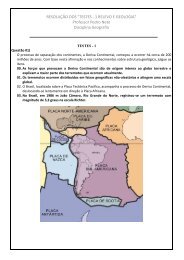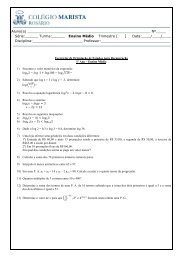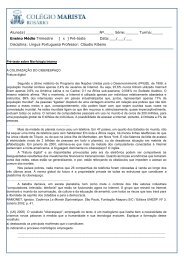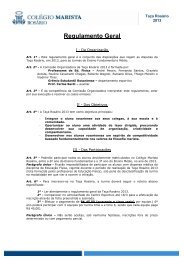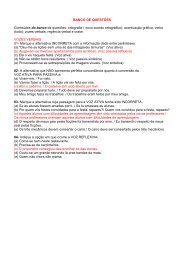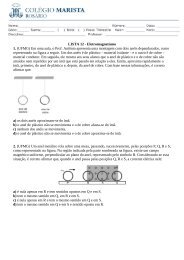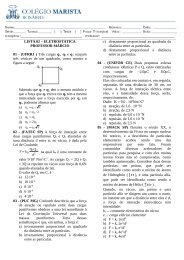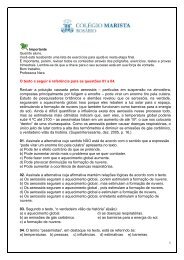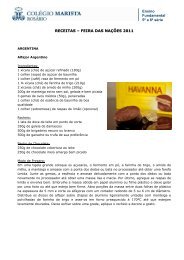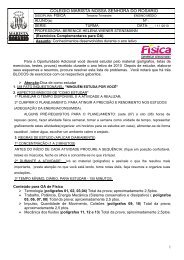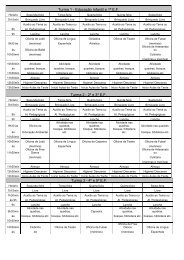NÚMEROS COMPLEXOS 1) Calculando-se corretamente as raízes ...
NÚMEROS COMPLEXOS 1) Calculando-se corretamente as raízes ...
NÚMEROS COMPLEXOS 1) Calculando-se corretamente as raízes ...
You also want an ePaper? Increase the reach of your titles
YUMPU automatically turns print PDFs into web optimized ePapers that Google loves.
Aluno(a) _________________________________ Nº.____ Ano: 3º do Ensino Médio<br />
Exercícios para a Recuperação de MATEMÁTICA - Professores: Escossi e Luciano<br />
<strong>NÚMEROS</strong> <strong>COMPLEXOS</strong><br />
1) <strong>Calculando</strong>-<strong>se</strong> <strong>corretamente</strong> <strong>as</strong> <strong>raízes</strong> da função f(x) = x 2 + 4x + 5, encontram-<strong>se</strong><br />
valores complexos de x iguais a:<br />
a) – 2 + i e – 2 – i<br />
b) – 2 + 2i e – 2 – 2i<br />
c) – 1 + 2i e – 1 – 2i<br />
d) 1 + 2i e 1 – 2i<br />
e) 2 + i e 2 – i<br />
2) Se z = (2 + i).(1 + i).i, então z ,<strong>se</strong>rá dado por:<br />
a) – 3 – i<br />
b) 1 – 3i<br />
c) 3 – i<br />
d) – 3 + i<br />
e) 3 + i<br />
3) O valor da expressão<br />
a) (i + 1)<br />
b)- (i – 1)<br />
c)<br />
d)<br />
e)<br />
<br />
i 1<br />
2<br />
i 1<br />
2<br />
<br />
1<br />
i<br />
2<br />
x<br />
x<br />
2<br />
3<br />
1<br />
1<br />
quando x = i é:<br />
7<br />
7<br />
<br />
4) A forma algébrica do complexo z = 3 cos i . <strong>se</strong>n é:<br />
6 6 <br />
3 3 3<br />
<br />
2 2<br />
a) z = i<br />
3 3 3<br />
<br />
2 2<br />
b) z = i<br />
3 3 3<br />
<br />
2 2<br />
c) z = i<br />
3 3 3<br />
d) z = i<br />
2 2<br />
3 3 3<br />
e) z = i<br />
2 2<br />
5) Dados os números complexos z e z , é correto afirmar que z + z é um número:<br />
a) natural.<br />
b) inteiro.<br />
c) racional.<br />
d) real.<br />
e) imaginário puro.
6) O inverso do número complexo z = 2 + i é:<br />
1<br />
<br />
2<br />
a) i<br />
2 1<br />
<br />
5 5<br />
b) i<br />
1<br />
<br />
2<br />
c) i<br />
d) – 2 + i<br />
1 2<br />
<br />
5 5<br />
e) i<br />
7) O número complexo z tal que z = 3i 97 + 2i 75 + 9i 18 é:<br />
a) – 14i<br />
b) 8i<br />
c) 1 – 4i<br />
d) 9 +i<br />
e) – 9 – i<br />
8) Considerando z = – 1 – i, de módulo e argumento , é falso dizer que:<br />
a) o afixo de z pertence ao 3º quadrante.<br />
b) z . z = 2<br />
c) z 2 = 2 . z + 2<br />
d) 3 = 8<br />
e) tg = 1<br />
1<br />
i<br />
1<br />
i<br />
9) A forma trigonométrica (ou polar) do número complexo 2<br />
a) 45°<br />
b) 90°<br />
c) 135°<br />
d) 225°<br />
e) 315°<br />
tem argumento igual a:<br />
10) Considere os complexos u = 4 + i, v = 2 + 3i e w = 6 + 4i, cujos afixos,em relação a<br />
um sistema de eixos perpendiculares, são, respectivamente, P, Q e R. Sendo O a origem<br />
do sistema, a área do quadrilátero OPRQ é:<br />
a) 8<br />
b) 9<br />
c) 15<br />
d) 12<br />
e) 10<br />
11) Se i é a unidade imaginária, a soma 2 + 4 . i 2 + 6 . i 4 + ... + 100 . i 98 é um número:<br />
a) primo.<br />
b) divisível por 4.<br />
c) múltiplo de 6.<br />
d) negativo.<br />
e) quadrado perfeito.
12) A área do polígono cujos vértices são <strong>as</strong> repre<strong>se</strong>ntações geométric<strong>as</strong> d<strong>as</strong> <strong>raízes</strong><br />
do polinômio p(x) = x 6 – 1 é:<br />
3<br />
a) 2<br />
2<br />
b) 3<br />
3<br />
c) 2<br />
2<br />
d) 3<br />
3<br />
3<br />
3<br />
2<br />
2<br />
3<br />
e)<br />
4<br />
13) Se z = cos 40° + i. <strong>se</strong>n 40°, então z15 é igual a:<br />
a) 1<br />
b) – 1<br />
c)<br />
d)<br />
e)<br />
1<br />
i<br />
2<br />
1<br />
i<br />
2<br />
1<br />
i<br />
2<br />
3<br />
2<br />
3<br />
2<br />
3<br />
2<br />
14) Calcule o produto 25<br />
a) 20<br />
b) – 20<br />
c) 20<br />
d) 20i<br />
e) – 20i<br />
16. :<br />
15) O número complexo i<br />
<br />
a) cos + i <strong>se</strong>n<br />
6 6<br />
<br />
b) cos – i <strong>se</strong>n<br />
6 6<br />
c) 2(<strong>se</strong>n 6<br />
+ i cos 6<br />
)<br />
<br />
d) 2(<strong>se</strong>n – i cos )<br />
6 6<br />
<br />
e) 2(cos – i <strong>se</strong>n )<br />
6 6<br />
16) Se x = 2 i, então<br />
a) – 2<br />
2 2 2<br />
b) i<br />
3 3<br />
c) 2 + 2i<br />
d) 2 + 2 2 i<br />
e) 2 – 2 2 i<br />
3 é igual a:<br />
x x<br />
é:<br />
x1 3
17) Se m(cos + i <strong>se</strong>n ) = 1 + i, e 0 <br />
<br />
a) 2 e 2<br />
<br />
b) 1 e 4<br />
<br />
c) 2 e<br />
2<br />
d)<br />
<br />
2 e<br />
4<br />
e) 2 e 0<br />
18) O quociente<br />
a) i<br />
b) – i<br />
1 1<br />
c) i<br />
2 2<br />
1 1<br />
d) i<br />
2 2<br />
1 1<br />
<br />
2 2<br />
e) i<br />
1<br />
é igual a:<br />
5<br />
i 1<br />
19) Se m = 4 + 3i e n = 5 – 2i, então mn é:<br />
a) 20 – 6i<br />
b) 14 + 7i<br />
c) 26 – 23i<br />
d) 14 – 7i<br />
e) 26 + 7i<br />
2 , então os valores respectivos de m e são:<br />
20) Qual o valor de a para que o produto (2 + ai)(3 + i) <strong>se</strong>ja um imaginário puro?<br />
a) 5<br />
b) 6<br />
c) 7<br />
d)8<br />
e)10<br />
21) Sejam os números complexos m = 1 + i e n = 1 – i. Calcule o valor de m 52 .n – 51 .<br />
a) n<br />
b) m<br />
c) 2n<br />
d) 2m<br />
e) 1<br />
z 3 é?<br />
22) Se z = 4 + 2i, então o valor de z<br />
a) 6 + i<br />
b) 1 + 8i<br />
c) – 8 + 8i<br />
d) 1 – 8i<br />
e) 12 + 6i
23) O produto de 2 – bi pelo <strong>se</strong>u conjugado é 13, com b R. Os possíveis valores de b são:<br />
a) 0<br />
b) 2<br />
c) 3<br />
d) 13<br />
e) 13<br />
24) O inverso do complexo 2i, é:<br />
1<br />
<br />
2<br />
a) i<br />
1<br />
<br />
2<br />
b) i<br />
i<br />
c)<br />
2<br />
d) – 2<br />
e)<br />
i<br />
<br />
2<br />
25) Sendo z = 2 + i 3 , então o inverso de z 2 , é:<br />
5 4i<br />
a) 41<br />
2 i<br />
b) 5<br />
4 3<br />
<br />
25 25<br />
3 4<br />
<br />
25 25<br />
3 4<br />
<br />
25 25<br />
c) i<br />
d) i<br />
e) i<br />
26) O conjugado do número complexo<br />
1<br />
7i<br />
a)<br />
5<br />
1 i<br />
b)<br />
5<br />
1 2i<br />
c)<br />
7<br />
d)<br />
1<br />
7i<br />
5<br />
13i 2 i<br />
1 i<br />
e)<br />
5<br />
101 50<br />
( 2 i)<br />
.( 2 i)<br />
27) Simplificando , obtém-<strong>se</strong>:<br />
100<br />
49<br />
( 2<br />
i)<br />
.( 2<br />
i)<br />
a) 1<br />
b) 2 + i<br />
c) 2 – i<br />
d) – 5<br />
e) 5<br />
5<br />
3<br />
, é:
28) O módulo de um número complexo é igual a 2 e <strong>se</strong>u argumento é igual a 4<br />
forma algébrica des<strong>se</strong> número complexo é:<br />
a) 1 + i<br />
b) 2i<br />
c) 1 – i<br />
d) i<br />
e) – 1 – i<br />
29) O módulo de um número complexo é igual a 2<br />
forma algébrica des<strong>se</strong> número complexo é:<br />
a) 4 + 4i<br />
b) 2 + 2i<br />
c) 2 – 2i<br />
d) i<br />
e) i<br />
2 <br />
2 <br />
2<br />
2<br />
30) Se z = ( i<br />
a) 4 e 30°<br />
b) 12 e 80°<br />
c) 6 e 90°<br />
d) 6 e 90°<br />
e) 6 e 30°<br />
3 ). )<br />
2 e <strong>se</strong>u argumento é igual a 4<br />
5 , a<br />
, a<br />
3<br />
( 1<br />
3i<br />
então o módulo e o argumento de z são, respectivamente:<br />
2<br />
31) M e N são reais que satisfazem a igualdade 5i – 3(M – Ni) + 2i(M + Ni) = 0. Calcule M + N.<br />
a) – 6<br />
b) – 5<br />
c) – 1<br />
d) 1<br />
e) 5<br />
32) Resolva a equação z 2 = 5zi, onde z C:<br />
a) 5i<br />
b) 0 e 5i<br />
c) 0 e – 5i<br />
d) – 5i e 5i<br />
e) – 5 e 5<br />
1<br />
i<br />
33) Determine a forma trigonométrica de z = . 5<br />
i<br />
a) 2 (cos 135° + i <strong>se</strong>n 135°)<br />
b) 2(cos 45° + i <strong>se</strong>n 45°)<br />
c) cos 120° + i <strong>se</strong>n 120°<br />
d) 2(cos 315° + i <strong>se</strong>n 315°)<br />
e) 2 (cos 225° + i <strong>se</strong>n 225°)<br />
34) Considere <strong>as</strong> <strong>se</strong>guintes afirmações:
I) O produto de dois números complexos conjugados é um número real;<br />
II) O módulo de um número complexo é um número real não negativo;<br />
III) O argumento de qualquer número complexo na forma z = bi (b 0) vale 2<br />
Quais afirmações estão corret<strong>as</strong>?<br />
a) II<br />
b) II e III<br />
c) I e II<br />
d) I e III<br />
e) I, II e III<br />
35) A razão entre o módulo de um número complexo não nulo e o módulo de <strong>se</strong>u conjugado<br />
é:<br />
a) – 2<br />
b) – 1<br />
1<br />
c)<br />
2<br />
d) 1<br />
e) 2<br />
36) A igualdade (2 + 2i) n = (2 – 2i) n <strong>se</strong> verifica <strong>se</strong> e somente <strong>se</strong>:<br />
a) n = 4k, k Z<br />
b) n = 0<br />
c) n é ímpar<br />
d) n é par<br />
e) n é primo<br />
37) Ob<strong>se</strong>rvando a figura, z é igual a:<br />
2<br />
<br />
2<br />
2<br />
2<br />
a) i<br />
b) <br />
2<br />
<br />
2<br />
2<br />
i<br />
2<br />
c) i<br />
2 <br />
2<br />
d) 2 2 i<br />
e) i<br />
2 <br />
2<br />
.
38) A expressão<br />
a) 0<br />
b) 1<br />
c) i<br />
d) 3<br />
e) 3<br />
3 i<br />
<br />
3 i<br />
39) O valor de ( 3 + i) 6 é:<br />
a) 64 – 64i<br />
b) – 64i<br />
c) 64i<br />
d) – 64<br />
e) 64<br />
3 i<br />
3 i<br />
é igual a:<br />
40) Se (m + ni)(2 – i) = 20, então m + n é igual a:<br />
a) 8<br />
b)10<br />
c) 12<br />
d) 18<br />
e) 20<br />
41) A raiz x da equação m 2 x – n = 0, para m = 1 + i e n = 2 – i, é:<br />
1<br />
<br />
2<br />
a) i<br />
1<br />
b) i<br />
2<br />
1<br />
<br />
2<br />
c) i<br />
1<br />
<br />
2<br />
d) i<br />
e) – 1 – 2i<br />
42) Dados os números complexos z1 = i<br />
7 2 , z2 = 1 + i<br />
é:<br />
a) z1 e z2 têm mesmo conjugado;<br />
b) a parte real de z1 é menor que a parte real de z2;<br />
c) a soma de z1 com z3 é um número real;<br />
d) a parte imaginária de z3 é zero;<br />
e) z1, z2 e z3 têm módulos iguais.<br />
2 2 e z3 = 3i. A alternativa correta<br />
43) O número complexo z e <strong>se</strong>u conjugado z satisfazem a igualdade iz+ 2 z = – 6 + 3i.<br />
O módulo do número complexo z é igual a:<br />
a) 3<br />
b) 3<br />
c) 9<br />
d) 41<br />
e) 41
44) A repre<strong>se</strong>ntação gráfica no plano de Argand-Gauss, do conjunto dos números complexos<br />
z tais que 2 |z| < 5 é:<br />
45) O número z = (a – 3) + (a 2 – 9)i <strong>se</strong>rá um número real não nulo para:<br />
a) a = – 3<br />
b) a < – 3 ou a > 3<br />
c) – 3 < a < 3<br />
d) a = 3<br />
e) a > 0<br />
46) Considere z1 = – 3 + 2i e z2 = 4 + i. A repre<strong>se</strong>ntação polar de z1 + 2<br />
a)<br />
<br />
cos i <strong>se</strong>n<br />
4 4<br />
2<br />
<br />
cos i <strong>se</strong>n<br />
4 4<br />
b) <br />
c)<br />
3<br />
3<br />
cos i <strong>se</strong>n<br />
4 4<br />
7<br />
7<br />
2 cos i <strong>se</strong>n<br />
4 4<br />
d) <br />
e)<br />
7<br />
7<br />
cos <br />
i <strong>se</strong>n<br />
4 4<br />
z é:
47) Os vértices do retângulo hachurado da figura abaixo repre<strong>se</strong>ntam os números<br />
complexos p, q, r e s.<br />
Pode-<strong>se</strong> afirmar que p + q + r + s é o número complexo:<br />
a) – i<br />
b) i<br />
c) 1<br />
d) 0<br />
e) 1 + i<br />
48) Se w = cos 30° + i <strong>se</strong>n 30° e z = cos 120° + i <strong>se</strong>n 120°, então<br />
a) w 2 + z 2 = 0<br />
b) w + z = 0<br />
c) w 2 – z 2 = 0<br />
d) w – z = 0<br />
e) w 4 + z 4 = 0<br />
49)Considere a figura, onde u e v são números complexos.<br />
Se v = u +<br />
u<br />
a) – 1 + i<br />
1 1<br />
<br />
2 2<br />
b) i<br />
3 3<br />
c) i<br />
2 2<br />
d) <br />
2<br />
<br />
2<br />
2<br />
i<br />
2<br />
1<br />
e) <br />
<br />
2<br />
3<br />
i<br />
2<br />
1 , então u vale:
50) Os vértices de um triângulo são pontos do plano que repre<strong>se</strong>ntam <strong>as</strong> <strong>raízes</strong> complex<strong>as</strong><br />
de 27. O perímetro des<strong>se</strong> triângulo é:<br />
a) 3<br />
3<br />
b) 3<br />
c) 9<br />
d) 9 3<br />
e) 27<br />
6<br />
51) (1 + i) 15 é igual a;<br />
a) 64(1 + i)<br />
b) 128(1 – i)<br />
c) 128(–1 – i)<br />
d) 256(– 1 + i)<br />
e) 256(1 + i)<br />
52) Se u é um número complexo, <strong>as</strong> repre<strong>se</strong>ntações gráfic<strong>as</strong> de u e ui podem <strong>se</strong>r:
Respost<strong>as</strong> dos testes:<br />
1.A 2.A 3.B 4.C 5.D 6.B 7.E 8.D<br />
9.D 10.E 11.D 12.A 13.D 14.B 15.E 16.B<br />
17.D 18.D 19.E 20.B 21.A 22.C 23.C 24.E<br />
25.D 26.A 27.D 28.E 29.B 30.D 31.C 32.B<br />
33.A 34.C 35.D 36.A 37.D 38.E 39.D 40.C<br />
41.A 42.E 43.D 44.A 45.A 46.B 47.D 48.A<br />
49.E 50.D 51.B 52.A
POLINÔMIOS<br />
1. O resto da divisão do polinômio p(x) = 3x 2 – 17x + 27 por q(x) = x – 4 é:<br />
a) 4<br />
b) 7<br />
c) 2x<br />
d) 5<br />
e) 5x – 20<br />
2) A divisão do polinômio p(x) = x 5 – 2x 4 – x + m por q(x) = x – 1 é exata. O valor de m é:<br />
a) – 2<br />
b) – 1<br />
c) 0<br />
d) 1<br />
e) 2<br />
3) O valor de k para que o resto da divisão do polinômio p(x) = x 3 – kx + 1 por x + 3 <strong>se</strong>ja 7 é:<br />
a) 7<br />
b) – 9<br />
c) – 11<br />
d) 9<br />
e) 11<br />
4) Considere os polinômios p(x) = x 2 – 2x + 1, q(x)=x 3 +x–2 e r(x) = – x 5 +2x 4 – x 3 +x 2 – x + 1.<br />
O grau do polinômio p(x).q(x) + r(x) é:<br />
a) 5<br />
b) 4<br />
c) 3<br />
d) 2<br />
e) 1<br />
5) O resto da divisão de x 3 + 4x – 1 por x 2 + 1 é igual a:<br />
a) 1<br />
b) 5x – 1<br />
c) 5x + 1<br />
d) 3x + 1<br />
e) 3x – 1<br />
6) As soluções da equação q(x) = 0 onde q(x) é o quociente do polinômio<br />
x 4 – 12x 3 + 34x 2 + 12x – 35 por x 2 – 6x + 5 é:<br />
a) – 1 e 5<br />
b) 1 e – 7<br />
c) – 1 e 7<br />
d) – 1 e – 5<br />
e) – 1 e 6
7) O resto da divisão de P(x) = ax 3 – 2x + 1 por Q(x) = x – 3 é 4. Ness<strong>as</strong> condições, o valor<br />
de a é:<br />
a) 1<br />
3<br />
b) 1<br />
2<br />
c) 2<br />
3<br />
d) 3<br />
2<br />
e) 1<br />
8) Sejam os polinômios f = x 2 + 2px + q e g = (x – p).(x + q), com p e q reais não-nulos. Se<br />
f é idêntico a g, então o valor de p + q é igual a:<br />
a) – 4<br />
b) – 3<br />
c) – 2<br />
d) 0<br />
e) 1<br />
9) Se o polinômio x 4 + px 2 + q é divisível pelo polinômio x 2 – 6x + 5, então p + q vale:<br />
a) – 1<br />
b) 3<br />
c) 5<br />
d) – 4<br />
e) 10<br />
10) Dividindo-<strong>se</strong> p(x) = 2x 3 – 3x 2 + 8x + 3 por s(x), obtém-<strong>se</strong> um quociente q(x) = 2x – 1 e<br />
um resto r(x) = 3x + 5. Então s(x) é igual a:<br />
a) x 2 + x + 1<br />
b) x 2 – x + 1<br />
c) 2x 2 +3x – 5<br />
d) x 2 + x – 2<br />
e) x 2 – x + 2<br />
11) Os respectivos graus dos polinômios f, g e h são três números naturais con<strong>se</strong>cutivos.<br />
Se o grau do produto f.g.h é 15, então o grau da soma f + g + h é igual a:<br />
a) 2<br />
b) 3<br />
c) 4<br />
d) 5<br />
e) 6<br />
12) O polinômio p(x) = 2x 3 + ax 2 – bx + 5 é divisível por x – 1. Dividido por x + 1, deixa<br />
resto 2. Então, o valor de a + 2b é:<br />
a) – 6<br />
b) – 10<br />
c) 2<br />
d) 3<br />
e) – 4
13) Para que <strong>se</strong>jam idênticos os polinômios p(x) =<br />
valor de a + b + c deve <strong>se</strong>r igual a:<br />
a) 1<br />
b) 2<br />
c) 3<br />
d) 4<br />
e) 5<br />
x b a<br />
2<br />
2<br />
cx x e g(x) = x3 – 4x2 + x + 4, o<br />
1 1 1<br />
14) Sabe-<strong>se</strong> que na divisão de um polinômio f por x 2 – 1 obtém-<strong>se</strong> quociente x – 3 e resto<br />
4x – 1. O resto da divisão de f por x – 3 é:<br />
a) 4x – 1<br />
b) 1 – 4x<br />
c) 7<br />
d) 8<br />
e) 11<br />
15) Sabe-<strong>se</strong> que o polinõmio f = x 3 – 4x 2 + x + m, no qual m é uma constante real, é<br />
divisível por x – 2. Qual é o quociente da divisão de f por x + 1 ?<br />
a) x 2 – 5x + 12<br />
b) x 2 + 5x + 12<br />
c) x 2 – 5x – 6<br />
d) x 2 + 5x + 6<br />
e) x 2 – 5x + 6<br />
16) A igualdade 2<br />
2x1 A B<br />
<br />
x xxx 1<br />
condições, pode-<strong>se</strong> afirmar que o valor de A + B é:<br />
a) 2<br />
b) 5<br />
c) 8<br />
d) 11<br />
e) 13<br />
é verdadeira para todo número real x. Ness<strong>as</strong><br />
17) O valor de m para o qual x + 2 é fator de x 3 – 3x 2 + mx – 12 é:<br />
a) 20<br />
b) – 20<br />
c) 16<br />
d) – 16<br />
e) 0<br />
18) O resto da divisão x 5 – ax 4 + 3 por x + 1 é – 2. O valor de a é:<br />
a) 4<br />
b) 3<br />
c) 0<br />
d) – 3<br />
e) – 4
19) Os valores de m e n tais que: 2<br />
a) 2 e 1<br />
b) 3 e 2<br />
c) 1 e 2<br />
d) 2 e 3<br />
e) 1 e 3<br />
x 1 m n<br />
<br />
x xx1 x<br />
, são respectivamente:<br />
20) Se f e g são polinômios de graus4 e 5 respectivamente, então o grau de:<br />
a) f + g é 5<br />
b) f.g é 20<br />
c) f + g é 9<br />
d) f.g é 10<br />
e) g – p é 4<br />
21) Se g(x) é um polinômio de grau 4, então o grau de [g(x)] 3 + [g(x)] 2 + 2g(x) é:<br />
a) 4<br />
b) 8<br />
c) 12<br />
d) 16<br />
e) 24<br />
22) A divisão de f(x) por x 2 + 1 tem quociente x – 2 e resto 1. O polinômio f(x) é:<br />
a) x 2 + x – 1<br />
b) x 2 + x + 1<br />
c) x 2 + x<br />
d) x 3 – 2x 2 + x – 2<br />
e) x 3 – 2x 2 + x – 1<br />
23) Se a divisão do polinõmio f(x) = x 3 + mx 2 – nx + 3 por g(x) = x 2 – x + 1, for exata, então<br />
os valores de m e n são, respectivamente:<br />
a) 2 e 1<br />
b) 1 e 2<br />
c) 2 e 2<br />
d) 1 e 1<br />
e) 3 e 3<br />
24) O resto da divisão do polinômio x 100 por x + 1 é:<br />
a) x – 1<br />
b) x<br />
c) – 1<br />
d) 0<br />
e) 1<br />
25) Para que x4 – mx3 + 5x2 + 5x – ( m + 1) <strong>se</strong>ja divisível por x – 1, m deve <strong>se</strong>r igual a:<br />
a) – 5<br />
b) 1<br />
<br />
5<br />
c) 1<br />
5<br />
d) 1<br />
e) 5
26) O resto da divisão de g(x) = x 3 + mx 2 – x + m por x – 1 é 4. O valor de m é:<br />
a) 0<br />
b) 1<br />
c) 2<br />
d) 4<br />
e) 6<br />
27) O valor de a de modo que – 1 <strong>se</strong>ja raiz de x 3 + (a + 2)x 2 + (1 – a)x – 2 = 0 é igual a:<br />
a) 0<br />
b) – 1<br />
c) 1<br />
d) – 2<br />
e) 2<br />
28) Seja P(x) um polinômio de 1º grau. Se P(1) = 5 e P(- 1) = 1, então P(x) é:<br />
a) 10x – 3<br />
b) 5x – 1<br />
c) x + 4<br />
d) 5x + 1<br />
e) 2x + 3<br />
29) Se f(x) e g(x) são polinômios de graus respectivamente iguais a a e a b, então o grau de<br />
– 5(x – 1) 3 .f(x).g 4 (x) é?<br />
a) 12ab<br />
b) 12ab 4<br />
c) 3ab 4<br />
d) 3 + a + 4b<br />
e) 3 + a + b 4<br />
30) O valor de k para que o polinômio (k 3 + k 2 – 6k)x 3 – kx 2 +7 = 0 <strong>se</strong>ja de grau 2 é?<br />
a) 2 ou 0<br />
b) 2 ou – 3<br />
c) 2 ou 1<br />
d) – 3 ou 0<br />
e) – 2 ou 3<br />
31) O resto da divisão de P(x) = x 5 – 2x 4 + x 2 + 1 por d(x) = 2x – 1 é:<br />
a) – 1<br />
b) 1<br />
c) 3<br />
32<br />
d) 29<br />
32<br />
e) 37<br />
32<br />
32) Se q(x) é o quociente da divisão de p(x) = x 3 – 12x 2 + 41x – 30 por<br />
d(x) = x 2 – 7x + 6, então q(3) é igual a?<br />
a) – 8<br />
b) – 2<br />
c) 2<br />
d) 3<br />
e) 8
33) Na divisão de p(x) = 4x3 – 7x + 5 por d(x), o quociente é q(x) = x – 2 e o é resto r(x) = 23.<br />
O valor de d( 3<br />
a) – 12<br />
b) 6<br />
c) 9<br />
d) 12<br />
e) 30<br />
) é:<br />
2<br />
34) Considere <strong>as</strong> afirmações:<br />
I) Se f(x) e g(x) são polinômios de grau k, então f(x) + g(x) é um polinômio de grau 2k;<br />
II) O resto da divisão de f(x) = kx 3 + x 2 – x por d(x) = x – 1 é igual a k;<br />
III) O produto de um polinômio de grau k por (x – m) é um polinômio de grau k + 1.<br />
Estão corret<strong>as</strong> <strong>as</strong> afirmações:<br />
a) I<br />
b) I e II<br />
c) III<br />
d) II e III<br />
e) I, II e III<br />
Respost<strong>as</strong> dos testes de vestibulares<br />
1.B 2.E 3.E 4.C 5.E 6.C 7.A<br />
8.A 9.A 10.E 11.E 12.C 13.E 14.E<br />
15.E 16.A 17.D 18.A 19.C 20.A 21.C<br />
22.E 23.C 24.E 25.E 26.C 27.C 28.E<br />
29.D 30.B 31.E 32.B 33.B 34.D XXX
EQUAÇÕES ALGÉBRICAS<br />
1. Se x 4 – 3x 3 + 2x 2 + 2x – 4 = 0 admite a raiz complexa 1 – i, então a soma d<strong>as</strong> du<strong>as</strong> <strong>raízes</strong> reais dessa<br />
2. equação é:<br />
a) – 3<br />
b) – 1<br />
c) 1<br />
d) 2<br />
e) 8<br />
2. Uma d<strong>as</strong> <strong>raízes</strong> do polinômio x 3 + 2x 2 – 9x – 18 é – 2. A soma d<strong>as</strong> outr<strong>as</strong> du<strong>as</strong> <strong>raízes</strong> é:<br />
a) – 2<br />
b) – 1<br />
c) 0<br />
d) 1<br />
e) 2<br />
3. Se – 2 é raiz dupla da equação x 3 – mx 2 + n = 0, então m e n são, respectivamente:<br />
a) 2 e – 4<br />
b) 2 e – 3<br />
c) 2 e 3<br />
d) – 3 e – 4<br />
e) – 4 e 3<br />
4. Um polinômio p(x) de grau 3 tem <strong>as</strong> <strong>se</strong>guintes propriedades:<br />
É divisível por x + 2<br />
O resto da divisão por x – 1 é 3<br />
Zero é uma raiz de multiplicidade 2<br />
O polinômio p(x) tem equação:<br />
a) p (x) = x 3 + 2x<br />
b) p(x) = 2x 3 + x 2<br />
c) p(x) = x 3 + x 2 + 1<br />
d) p(x) = x 3 + 2x 2<br />
e) p(x) = 3x 3<br />
5. O polinômio p(x) está repre<strong>se</strong>ntado pela curva da figura. A expressão que pode repre<strong>se</strong>ntar o polinômio<br />
p(x) é:<br />
a) x(x – 1) 4<br />
b) x(x – 1) 3<br />
c) x(x – 1)<br />
d) x 2 (x – 1)<br />
e) x 3 (x – 1)<br />
6. O gráfico repre<strong>se</strong>nta a função y = p(x). Sabendo-<strong>se</strong> que p(x) é um polinômio com <strong>raízes</strong> reais, tod<strong>as</strong><br />
el<strong>as</strong> apre<strong>se</strong>ntad<strong>as</strong> no gráfico, <strong>as</strong>sinale a afirmativa incorreta:<br />
a) o polinômio tem uma raiz múltipla;<br />
b) o polinômio tem três <strong>raízes</strong> distint<strong>as</strong>;<br />
c) o grau do polinômio é par;<br />
d) o termo independente do polinômio é zero;<br />
e) o número total de <strong>raízes</strong> do polinômio é 3.
7. O gráfico repre<strong>se</strong>nta a função y = f(x). O conjunto {x R | f(x) < 0} é igual a:<br />
a) ]1,3[<br />
b) ] – , –1[ U ]1, 3[<br />
c) ] – , –1[ U ]1, + [<br />
d) ] – , 0[<br />
e) ] – 2, 0[<br />
8. O polinômio p(x) tem coeficientes reais, é divisível por x 2 + 4 e p(1 – i) = 0. Com es<strong>se</strong>s dados pode-<strong>se</strong><br />
afirmar que o menor grau que p(x) pode ter é:<br />
a) 2<br />
b) 3<br />
c) 4<br />
d) 5<br />
e) 6<br />
9. A equação x 3 – 3x 2 + 7x – 5 = 0 tem <strong>raízes</strong> a, b e c. Dentre os números dados por |a|, |b| e |c|, o maior é:<br />
a) 1<br />
b) 2<br />
c) 5<br />
d) 5<br />
e) 7<br />
10. Um fator de p(x) = x 3 – 1 é:<br />
a) x 2 + x + 1<br />
b) x 2 – x + 1<br />
c) x 2 – 1<br />
d) x + 1<br />
e) (x – 1) 3<br />
11. A função polinomial que melhor <strong>se</strong> identifica com a figura é definida por:<br />
a) p(x) = x 2 + 3x + 2<br />
b) p(x) = – x 2 + 3x –2<br />
c) p(x) = 2(x – 1)(x – 2)<br />
d) p(x) = x 3 – 4x 2 + 5x + 2<br />
e) p(x) = – x 3 + 4x 2 – 5x + 2<br />
12. A equação algébrica de <strong>raízes</strong> – 2, 0 e 1 é:<br />
a) x 2 – x = 0<br />
b) x 2 – 2x = 0<br />
c) x 3 + x 2 – 2x = 0<br />
d) x 3 – x 2 – 2x = 0<br />
e) x 3 + 2 = 0
13. O quadrado da soma d<strong>as</strong> <strong>raízes</strong> da equação x 3 + 4x 2 – 2x – 3 = 0 é:<br />
a) 13<br />
2<br />
b) 19<br />
2<br />
c) 15<br />
d) 16<br />
e) 19<br />
14. Sendo – 3 uma raiz da função polinomial f(x) = 2x 3 – 4x 2 – 18x + 36, a soma d<strong>as</strong> demais <strong>raízes</strong> é:<br />
a) – 1<br />
b) 2<br />
c) 3<br />
d) 4<br />
e) 5<br />
15. Se – 3, 1 e 2 são <strong>raízes</strong> de p(x) = x 3 + mx 2 +nx + p, então o quociente de p(x) por (x – 1) é:<br />
a) x 2 + x + 6<br />
b) x 2 + x – 6<br />
c) x 2 – x – 6<br />
d) x 2 + 5x + 6<br />
e) x 2 + 5x – 6<br />
16. Se a e b são <strong>as</strong> <strong>raízes</strong> da equação 7x 2 + 9x + 21 = 0, então (a + 7)(b + 7) vale:<br />
a) 49<br />
b) 43<br />
c) 37<br />
d) 30<br />
e) 30<br />
7<br />
17. Se os números – 3, m e n são <strong>as</strong> <strong>raízes</strong> da equação x 3 + 5x 2 – 2x – 24 = 0, então o valor de m + n é:<br />
a) – 6<br />
b) – 2<br />
c) – 1<br />
d) 2<br />
e) 6<br />
18. A multiplicidade da raiz 1 da equação x 4 – x 3 – 3x 2 + 5x – 2 = 0 é:<br />
a) 1<br />
b) 2<br />
c) 3<br />
d) 4<br />
e) 5<br />
19. Seja p(x) = x 3 + 6x 2 – x – 30. Se p(2) = 0, então, o conjunto solução de p(x) = 0 é:<br />
a) {– 2, – 3, – 5}<br />
b) {2, – 3, – 5}<br />
c) {2, – 2, – 2}<br />
d) {2, 3, 5}<br />
e) {2, 6, 30}
20. Um polinômio p(x) de terceiro grau tem <strong>raízes</strong> 1 e 2. S e p(– 1) = 4, a terceira raiz de p(x) é:<br />
a) 2<br />
3<br />
b) 5<br />
3<br />
<br />
3<br />
c) 5<br />
d) 3<br />
e) – 3<br />
21. O número de <strong>raízes</strong> reais do polinômio p(x) = (x 2 + 1)(x – 1)(x + 1) é:<br />
a) 0<br />
b) 1<br />
c) 2<br />
d) 3<br />
e) 4<br />
22. A equação que admite <strong>as</strong> <strong>raízes</strong> – 1, 1<br />
a) x 5<br />
3<br />
x<br />
2<br />
4 – 2x 3 + 3<br />
2 x2 + x 1<br />
b) 2x 5 – 5x 4 + 5x 2 – 2x = 0<br />
c) 2x 5 – 5x 4 + 4x 3 – 5x 2 + 2 = 0<br />
d) 2x 4 – 3x 5 – 4x 2 + 3x + 2 = 0<br />
e) 2x 5 – 3x 4 – 4x 3 + 3x 2 + 2x = 0<br />
= 0<br />
2<br />
23. Uma raiz da equação z 4 – z – 1 + i = 0 é:<br />
a) i<br />
b) – i<br />
c) 1<br />
d) – 1<br />
e) 0<br />
, 0, 1 e 2 é:<br />
2<br />
24. Dado que n é um número par, o número de <strong>raízes</strong> reais da equação x n + 1 = 0 é:<br />
a) 0<br />
b) 1<br />
c) 2<br />
d) n<br />
e) infinito<br />
25. A soma d<strong>as</strong> <strong>raízes</strong> da equação x 3 + 2x 2 – x – 2 = 0 é:<br />
a) – 2<br />
b) – 1<br />
c) 0<br />
d) 1<br />
e) 2<br />
26. O menor grau que pode ter uma equação algébrica de coeficientes reais com <strong>raízes</strong> 2, i e 1 + i é:<br />
a) 6<br />
b) 5<br />
c) 4<br />
d) 3<br />
e) 2
27. O polinômio do 3º grau cujo gráfico está repre<strong>se</strong>ntado na figura a <strong>se</strong>guir é:<br />
a) 3<br />
x – 3<br />
b) 3<br />
c) 1<br />
2 x3 – 6x 2 + 15<br />
4 x3 – 15<br />
2<br />
4 x2 + 6x – 3<br />
2 x3 – 5<br />
2 x2 + 4x – 3<br />
d) x 3 – 4x 2 + 5x – 2<br />
e) x 3 – 5x 2 + 8x – 4<br />
28. O valor de m que torna iguais <strong>as</strong> <strong>raízes</strong> da equação 3x 2 + 2x + m = 0 é:<br />
a) 1<br />
3<br />
b) 1<br />
2<br />
c) 2<br />
d) 3<br />
e) não existe<br />
29. Os reais 1, a e b são soluções distint<strong>as</strong> de x 3 – 6x 2 + 11x – 6 = 0. O valor de a + b é:<br />
a) – 6<br />
b) – 5<br />
c) 5<br />
d) 6<br />
e) 11<br />
30. Considere o gráfico abaixo.<br />
Es<strong>se</strong> gráfico pode repre<strong>se</strong>ntar a função definida por:<br />
a) f(x) = x 3 + 5x 2 – 20x<br />
b) f(x) = x 3 + 5x 2 – 4x – 20<br />
c) f(x) = x 4 + 5x 3 – 20x – 4<br />
d) f(x) = x 4 + 5x 3 – 4x – 20<br />
e) f(x) = x 4 + 5x 3 – 4x 2 – 20x<br />
31. Considerando <strong>as</strong> <strong>raízes</strong> do polinômio p(x) = x 4 + 16, pode-<strong>se</strong> afirmar que p(x):<br />
a) não tem <strong>raízes</strong> no conjunto dos números complexos<br />
b) tem uma raiz de multiplicidade 4<br />
c) tem quatro <strong>raízes</strong> complex<strong>as</strong> distint<strong>as</strong><br />
d) teem du<strong>as</strong> <strong>raízes</strong> dupl<strong>as</strong><br />
e) tem por gráfico uma curva que troca de concavidade
32. Considere o gráfico abaixo, que repre<strong>se</strong>nta uma função polinomial f, de terceiro grau e domínio R.<br />
Sendo g(x) = f(x) – 5, o número de <strong>raízes</strong> da equação g(x) = 0 é:<br />
a) 0<br />
b) 1<br />
c) 2<br />
d) 3<br />
e) 4<br />
33. O polinômio p(x) = x 4 + 4x 3 + 6x 2 + 4x + 1 tem :<br />
a) apen<strong>as</strong> du<strong>as</strong> <strong>raízes</strong> reais distint<strong>as</strong><br />
b) apen<strong>as</strong> du<strong>as</strong> <strong>raízes</strong> positiv<strong>as</strong><br />
c) tod<strong>as</strong> <strong>as</strong> <strong>raízes</strong> positiv<strong>as</strong><br />
d) quatro <strong>raízes</strong> iguais<br />
e) quatro <strong>raízes</strong> distint<strong>as</strong><br />
Respost<strong>as</strong> dos testes<br />
1- C 2- C 3- D 4- D 5- A 6- E 7- B 8- C 9- C<br />
10- A 11- E 12- C 13- D 14- E 15- B 16- B 17- B 18- C<br />
19- B 20- C 21- C 22- E 23- A 24- A 25- A 26- B 27- A<br />
28- A 29- C 30- E 31- C 32- B 33- D xxx xxx xxx
DISTÂNCIA ENTRE DOIS PONTOS<br />
1. A distância do ponto A ( -1, 2 ) ao ponto B ( 2, 6 ) é:<br />
a. 3<br />
b. 4<br />
c. 5<br />
d. 6<br />
e.<br />
GEOMETRIA ANALÍTICA<br />
2. A distância do ponto A ( a, a ) ao ponto B ( 6 a, 13 a ) é:<br />
a. 10<br />
b. 13<br />
c. 12 a<br />
d. 13 a<br />
e. 17 a<br />
3. O valor de y, para qual e distância do ponto A ( 1, 0 ) ao ponto B ( 5, y ) <strong>se</strong>ja 5 é:<br />
a. 3<br />
b. 4<br />
c. 3<br />
d. 2<br />
e. -1<br />
4. Os pontos pertencentes ao eixo d<strong>as</strong> absciss<strong>as</strong> que distam 13 unidades do ponto A ( -2, 5 ) têm<br />
absciss<strong>as</strong> cuja soma é:<br />
a. 4<br />
b. -4<br />
c. 24<br />
d. 14<br />
e. -12<br />
5. O ponto do eixo d<strong>as</strong> ordenad<strong>as</strong> equidistantes dos pontos A( 1, 2 ) e B ( -2, 3 ) tem ordenad<strong>as</strong> igual a :<br />
a. 4<br />
b. -4<br />
c. 3<br />
d. 5<br />
e. -5<br />
6. A som<strong>as</strong> d<strong>as</strong> coordenad<strong>as</strong> do ponto da reta suporte d<strong>as</strong> bis<strong>se</strong>trizes dos quadrantes impares equidistantes<br />
dos ponto A ( 1, 2 ) e B ( -2, 3 ) é:<br />
a. 4<br />
b. -4<br />
c. -10<br />
d. 10<br />
e. 0
8. O perímetro do triângulo ABC dados A ( -1, 1 ), B ( 4, 13 ) e C ( -1, 13 ) é:<br />
a. 30<br />
b. 15<br />
c. 17<br />
d. 25<br />
e. 22<br />
9. O valor real de x para que o triângulo formado pelos pontos A ( -1, 1 ), B ( 2, 5 ) e C ( x, 2) <strong>se</strong>ja retângulo<br />
em B é:<br />
a. 3<br />
b. 4<br />
c. 5<br />
d. 6<br />
e. -4<br />
10. ( CESCEA - SP ) O ponto do eixo Ox eqüidistante dos pontos ( 0, -1 ) e ( 4, 3 ) é:<br />
a. ( -1, 0 )<br />
b. ( 1, 0 )<br />
c. ( 2, 0 )<br />
d. ( 3, 0 )<br />
e. ( 8, 0 )<br />
11. ( PUC - SP ) Sendo A ( 3, 1 ) B ( 4, -4 ) e C ( -2, 2 ) vértices de um triângulo, então es<strong>se</strong> triângulo é:<br />
a. retângulo e não isósceles<br />
b. retângulo e isósceles<br />
c. equilátero<br />
d. isósceles e não retângulo<br />
e. escaleno e não retângulo<br />
PONTO MÉDIO<br />
1. A soma d<strong>as</strong> coordenad<strong>as</strong> do ponto médio do <strong>se</strong>gmento de extremidades ( -1, 4 ) e ( 3, 10 ) é:<br />
a. 16<br />
b. 18<br />
c. 10<br />
d. 8<br />
e. 6<br />
2. A soma d<strong>as</strong> coordenad<strong>as</strong> dos dois pontos, que dividem o <strong>se</strong>gmento de extremidades ( 0, 2 ) e ( 6, 11 ), em<br />
três <strong>se</strong>gmentos congruentes, é:<br />
a. 22<br />
b. 19<br />
c. 13<br />
d. 15<br />
e. 17<br />
4. A soma d<strong>as</strong> coordenad<strong>as</strong> do baricentro do triângulo ABC, <strong>se</strong>ndo A ( 0, 0 ), B ( 4, 1 ) e C ( 2, 8 ) é:<br />
a. -1<br />
b. 1<br />
c. 5<br />
d. 15
e. 7<br />
5. Um triângulo ABC é tal que o <strong>se</strong>u baricentro é o ponto ( 2, 1 ). Sendo A ( -1, 2 ) e B ( 3, 3 ) podemos<br />
afirmar que a ordenada de C é :<br />
a. 4<br />
b. -2<br />
c. -4<br />
d. -1<br />
e. -3<br />
6. A soma d<strong>as</strong> coordenad<strong>as</strong> do ponto simétrico de A ( 1, 2 ) em relação ao ponto P ( 4, 1 ) é :<br />
a. 7<br />
b. 6<br />
c. 13<br />
d. 11<br />
e. -8<br />
7. O comprimento da mediana relativa ao lado BC do triângulo ABC <strong>se</strong>ndo A (-1, 2), B ( 2, 3 ) e C ( 4, 7 )<br />
a. 4<br />
b. 3<br />
c. 5<br />
d. 6<br />
e. 2<br />
8. O comprimento da mediana relativa ao lado BC do triângulo ABC, <strong>se</strong>ndo A ( 2, 1 ) e G ( -4, 9 ), onde G é o<br />
baricentro, é:<br />
a.10<br />
b.12<br />
c.8<br />
d.15<br />
e.5<br />
COEFICIENTE ANGULAR EQUAÇÃO DA RETA<br />
1. A equação da reta que contém <strong>as</strong> bis<strong>se</strong>trizes do 1º e 3 º quadrantes é:<br />
a. y = 2x<br />
b. y = -x<br />
c. y = x<br />
d. y = x/2<br />
e. x = 3y<br />
2. A equação da reta que contém <strong>as</strong> bis<strong>se</strong>trizes do 2º e 4º quadrantes é :<br />
a. y = 2x<br />
b. y = -x<br />
c. y = x<br />
d. y = x/2
e. x = 3y<br />
3. A equação da reta que p<strong>as</strong>sa pela origem e pelo ponto A ( 2, 5 ) é :<br />
a. y = 2x<br />
b. y = 5x/2<br />
c. y = x/2<br />
d. y = x/5<br />
e. y + x = 0<br />
4. O coeficiente angular da reta que forma com o eixo d<strong>as</strong> absciss<strong>as</strong> um ângulo de 30º é:<br />
a. /3<br />
b.<br />
c. -<br />
d. - /3<br />
e. /3<br />
5. A reta que p<strong>as</strong>sa pelos pontos A ( 1, 2 ) e B ( -1, 6 ) intercepta o eixo d<strong>as</strong> absciss<strong>as</strong> no ponto:<br />
a. ( 1, 0 )<br />
b. ( 2, 0 )<br />
c. ( 0, 2 )<br />
d. ( -2, 0 )<br />
e. ( -1, 0 )<br />
6. A reta que p<strong>as</strong>sa pelos pontos A ( 2, -1 ) e B ( 3, 5 ) intercepta o eixo d<strong>as</strong> ordenad<strong>as</strong> no ponto:<br />
a. ( 0, 17 )<br />
b. ( 0, -17 )<br />
c. ( 0, 13 )<br />
d. ( 0, -13 )<br />
e. ( 0, -31 )<br />
7. A reta que p<strong>as</strong>sa pela origem do sistema cartesiano e pelo ponto P ( 2, 3 ) é:<br />
a. 2x - 3y = 0<br />
b. 3x - 2y = 0<br />
c. y = 2x<br />
d. y = 3x<br />
e. y = 2/3 x<br />
8. Uma equação da reta que intercepta os eixos coordenados nos pontos ( 0, 3 ) e ( -1, 0 ) é :<br />
a. y = - 3x<br />
b. y = - 3x + 3<br />
c. y = - 3x - 1<br />
d. y = 3x + 3<br />
e. y = x + 1<br />
9. Uma equação de reta que intercepta a bis<strong>se</strong>triz do primeiro quadrante, num ponto cuja abscissa é 2 e tem<br />
uma inclinação de 135º é:<br />
a. x - y - 4 = 0<br />
b. x + y - 4 = 0
c. x - y + 4 = 0<br />
d. x + y + 4 = 0<br />
e. x + y = 0<br />
10. Uma equação de reta que p<strong>as</strong>sa pelos pontos ( 3, 4 ) e ( 3, 7 ) é:<br />
a. x = 3<br />
b. y = 3<br />
c. y - x = 3<br />
d. y = - 3x<br />
e. y = 3x<br />
12. A equação da reta que é paralela à reta suporte d<strong>as</strong> bis<strong>se</strong>trizes dos quadrantes impares e p<strong>as</strong>sa pelo<br />
ponto ( 2, 3 ) é:<br />
a. x + y + 1 = 0<br />
b. x - y -1 = 0<br />
c. x + y - 1 = 0<br />
d. x - y + 1 = 0<br />
e. x - y - 2 = 0<br />
13. Sejam <strong>as</strong> ret<strong>as</strong> r: y = 6 e s: a reta que p<strong>as</strong>sa pela origem do sistema cartesiano e pelo ponto ( 3, 9 ). A<br />
área do triângulo formado por ess<strong>as</strong> ret<strong>as</strong> e pelo eixo d<strong>as</strong> ordenad<strong>as</strong> é:<br />
a. 12<br />
b. 10<br />
c. 8<br />
d. 6<br />
e. 4<br />
14. A equação da reta que p<strong>as</strong>sa pela origem e pelo vértice da parábola y = x 2 - 6x + 4 é<br />
a. 3x + 5y = 0<br />
b. 5x + 3y = 0<br />
c. 5x - 3y = 0<br />
d. 3x - 5y = 0<br />
e. x + y - 15 = 0<br />
15. O valor de m para que a reta de equação m.x + y - 2 = 0 p<strong>as</strong><strong>se</strong> pelo ponto A ( 1, -8 ) é:<br />
a. 10<br />
b. -10<br />
c. 6<br />
d. -6<br />
e. -1/8<br />
16. Os pontos ( a, 1 ) e ( 2, b ) estão sobre a reta x + 2y = 0. A distância entre eles vale:<br />
a. 2<br />
b.<br />
c.<br />
d. 2<br />
e. nda
17. ( PUC - SP ) As ret<strong>as</strong> 2x + 3y = 11 e x - 3y = 1 p<strong>as</strong>sam pelo ponto ( a, b ). Então a + b vale:<br />
a. 4<br />
b. 5<br />
c. 6<br />
d. -4<br />
e. 3<br />
18. ( FGV - SP ) A equação da reta na figura é:<br />
a. 3x + 2y = 6<br />
b. 3x - 2y = 6<br />
c. 2x + 3y = 6<br />
d. -3x + 2y = 6<br />
e. -2x + 3y = 6<br />
19. ( UEL - PR ) Seja a função y = mx + t repre<strong>se</strong>ntada no gráfico a <strong>se</strong>guir, os valores de m e t são<br />
respectivamente:<br />
a. -3/2 e -3<br />
b. -3/2 e 3<br />
c. 3/2 e 3<br />
d. 3 e -6<br />
e. 3 e 6<br />
20. ( FM ITAJUBA-MG ) O valor de m de modo que a reta de equação 2mx - 5y + 1 = 0 tenha coeficiente<br />
angular igual a 4 é:<br />
a. 20<br />
b. 5<br />
c. -10<br />
d. 10<br />
e. -20<br />
21. ( FGV - SP ) Considere o gráfico:<br />
A equação da reta r é:<br />
a. y = x + 1<br />
b. y = x+1<br />
c. 3y - x = 3<br />
d. 3y + x = 1<br />
e. y + x = 1
22. ( UFPR ) O ponto P ( -4, 3 ) é o ponto médio do <strong>se</strong>gmento da reta AB, cuj<strong>as</strong> extremidades estão sobre os<br />
eixos coordenados. Qual <strong>se</strong>rá a equação da reta AB ?<br />
a. x + y + 1 = 0<br />
b. x - y + 7 = 0<br />
c. 3 x - 4 y + 24 = 0<br />
d. 2 x + 3 y - 1 = 0<br />
e. 3 x + 2 y + 6 = 0<br />
23. O ponto de inter<strong>se</strong>cção d<strong>as</strong> ret<strong>as</strong> ( r ) x+y-5=0 e (s) 2x - y - 7 = 0 é:<br />
a. ( 1, 4 )<br />
b. ( 4, 1 )<br />
c. ( 12, 7 )<br />
d. ( -4, 9 )<br />
e. ( -1, 6 )<br />
24. A equação da reta que p<strong>as</strong>sa pela inter<strong>se</strong>cção d<strong>as</strong> ret<strong>as</strong> x + y - 3 = 0 e 2x - y + 5 = 0 e tem coeficiente<br />
angular igual a 3/4 é:<br />
a. 12x + 9y - 50 = 0<br />
b. 12y - 9x = 0<br />
c. 12y + 9x + 50 = 0<br />
d. 12y - 9x - 50 = 0<br />
e. nda<br />
25. O valor de K, para a reta kx - 4y + 2k = 0 p<strong>as</strong><strong>se</strong> no ponto de inter<strong>se</strong>cção d<strong>as</strong> ret<strong>as</strong> 2x - y + 3 = 0 e<br />
x + y - 9 = 0 é:<br />
a. 7<br />
b. 2<br />
c. 9<br />
d. 5<br />
e. -7<br />
26. (AMAM ) Qual a equação da reta que p<strong>as</strong>sa pelo ponto P ( 1, 2 ) e forma um ângulo de 45º com o<br />
<strong>se</strong>ntido positivo do eixo x ?<br />
a. y = x -1<br />
b. y = 2x + 1<br />
c. y = 1 - x<br />
d. y = x + 1<br />
e. y = 1 - 2x<br />
27. ( FUVEST - SP ) Sejam os pontos A ( 1, 1 ), B ( 2,2 ) e C ( 3, 1 ). A altura do triângulo ABC pelo vértice A<br />
tem equação:<br />
a. y = x<br />
b. y = x + 1<br />
c. y = 2x - 1<br />
d. y = 2x + 1<br />
e. 10y = 9x + 1
28. ( CESCEM. SP ) As ret<strong>as</strong> 2x - y + 3 = 0 e x - 2y + 6 = 0 interceptam-<strong>se</strong> :<br />
a. sobre o eixo d<strong>as</strong> ordenad<strong>as</strong>;<br />
b. no ponto ( -6, 0 )<br />
c. sobre o eixo d<strong>as</strong> absciss<strong>as</strong><br />
d. na origem dos eixos coordenados.<br />
e. no ponto ( 1, 5 )<br />
POSIÇÕES RELATIVAS DE DUAS RETAS<br />
1. (UEPG - PR) - Para que <strong>as</strong> ret<strong>as</strong> 2.x + m.y - 10 = O e m.x + 8.y + 5 = 0 <strong>se</strong>jam paralel<strong>as</strong>, o valor de m deve<br />
<strong>se</strong>r:<br />
a. 4<br />
b. - 4<br />
c. 4 ou -4<br />
d. -1<br />
e. nda<br />
2. (CEFET) - A reta 7.x - y + 7 = 0 determina um <strong>se</strong>gmento sobre os eixos coordenados. Qual a mediatriz<br />
des<strong>se</strong> <strong>se</strong>gmento?<br />
a. x + y - 25 = 0<br />
b. 7y + x = 0<br />
c. x + 7y - 24 = 0<br />
d. 7x + y + 7 = 0<br />
e. x + 7 y = 0<br />
3. (CESCEA) - As ret<strong>as</strong> e são paralel<strong>as</strong> <strong>se</strong>:<br />
a. p + m = 0<br />
b. m = - p<br />
c. p = m<br />
d. p/m = 1<br />
e. p.m = 1<br />
4. ( PUC - SP ) As ret<strong>as</strong> ( m-2 )x + 3y -1 = 0 e x + my + 2 = 0 são paralel<strong>as</strong>, somente <strong>se</strong>:<br />
a. m = 3<br />
b. m = -1<br />
c. m = 1<br />
d. m = 2<br />
e. m = 3 ou m = -1<br />
5. (UEPG-PR) A equação da mediatriz do <strong>se</strong>gmento cuj<strong>as</strong> extremidades são <strong>as</strong> inter<strong>se</strong>cções da reta<br />
x - 3y - 6 = 0 com os eixos coordenados é:<br />
a. 3x - y - 8 = 0<br />
b. 3x - y + 8 = 0<br />
c. 3x + y + 8 = 0<br />
d. 3x + y - 8 = 0<br />
e. nda
6. ( UFPR ) As equações d<strong>as</strong> ret<strong>as</strong> que p<strong>as</strong>sam pelo ponto ( 3, -5 ) e são uma paralela e outra perpendicular<br />
à reta 2x - y + 3 = 0 são :<br />
a. 2x-y - 11 = 0 e x + 2y + 7 = 0<br />
b. 2x + y - 11 = 0 e x + 2y + 7 = 0<br />
c. 2x + y + 11 = 0 e x + 2y + 7 = 0<br />
d. 2x + y - 11 = 0 e x - 2y - 7 = 0<br />
e. nda<br />
7. ( CESCEM - SP ) Para que a reta x - 3y + 15 = 0 <strong>se</strong>ja paralela a reta determinada pelos pontos A(a, b) e<br />
B ( -1, 2 ), o valor de a é:<br />
a. -3b + 5<br />
b. 3b - 5<br />
c. 3b - 7<br />
d. -3b + 7<br />
e. ( b/3 ) - ( 7/3 )<br />
9. A equação da reta suporte da altura relativa ao lado BC do triângulo ABC, de vértices A ( 1, 1 ),<br />
B ( -1, 2 ) e C ( 3, 6 ) é:<br />
a. x + y = 0<br />
b. x + y - 2 = 0<br />
c. x - y + 2 = 0<br />
d. x + y - 2 + 0<br />
e. x - y - 2 = 0<br />
11. ( ITA - SP ) Dad<strong>as</strong> <strong>as</strong> ret<strong>as</strong> r1: x + 2y - 5 = 0 , r2 : x - y - 2 = 0 e r3: x - 2y -1 = 0 podemos afirmar que:<br />
a. são 2 a 2 paralel<strong>as</strong><br />
b. r1 e r2 são paralel<strong>as</strong><br />
c.<br />
r1 é perpendicular a r3<br />
d. r2 perpendicular a r3<br />
e. <strong>as</strong> três ret<strong>as</strong> são concorrentes num mesmo ponto<br />
12 ( CEFET ) Qual é o ponto simétrico do ponto P ( 2, 3 ) em relação a reta x - y - 3 = 0 ?<br />
a. ( 4, -3 )<br />
b. ( 6, -1 ) e ( 4, -3 )<br />
c. ( 6, -1 )<br />
d. ( 2, -3 )<br />
e. ( 0, 1 )<br />
13. ( CEFET ) O valor de m para a qual a reta x + y/m = 0 e 2x - 2y + 1 = 0 são perpendiculares é:<br />
a. -1/2<br />
b. -1<br />
c. 1<br />
d. 1/2<br />
e. -2
14. ( FUVEST - SP ) São dados os pontos A ( 1, 1 ) e B ( 9, 3 ) . A mediatriz do <strong>se</strong>gmento AB encontra o eixo<br />
dos y no ponto de ordenada igual a :<br />
a. 20<br />
b. 21<br />
c. 22<br />
d. 23<br />
e. 24<br />
15. ( CEFET ) Determine a equação da reta que p<strong>as</strong>sa pelo ponto ( 0, -1 ) e é paralela à bis<strong>se</strong>triz dos<br />
quadrantes ímpares:<br />
a. x + y = -1<br />
b. x - 2y = 2<br />
c. x + 2y = -2<br />
d. x - y = 1<br />
e. x - y = -1<br />
ÁREA DE POLÍGONO<br />
1. ( UEL - PR ) Os pontos ( -2, 4 ) e ( 6, - 4 ) são os vértices de um triângulo equilátero. A área des<strong>se</strong><br />
triângulo, em unidades de superfície é:<br />
a. 16<br />
b. 24<br />
c. 48<br />
d. 72<br />
e. 96<br />
2. ( PUC - BA ) Considere o triângulo de vértices A ( 0, 0 ),B ( 1, 4 ) e C ( 4, 1 ). Sua altura em relação à ba<strong>se</strong><br />
BC mede :<br />
a. 2<br />
b.<br />
c. 4<br />
d. 4<br />
e. 5<br />
3. Dado um sistema de coordenad<strong>as</strong> cartesian<strong>as</strong> no plano, considere os pontos A (2, 2), B (4, -1) e<br />
C (m, 0) . Para que AC + CB <strong>se</strong>ja mínimo, o valor de m deve <strong>se</strong>r:<br />
a. 7/3<br />
b. 8/9<br />
c. 10/3<br />
d. 3,5<br />
e. 11/3
4. ( UFPR ) Em um sistema de cartesiano ortogonal, qual é a área do triângulo determinado pel<strong>as</strong> ret<strong>as</strong> de<br />
equações x - y - 1 = 0 , x = 5 e pelo eixo d<strong>as</strong> absciss<strong>as</strong> ?<br />
a. 8<br />
b. 12<br />
c. 16<br />
d. 6<br />
e. 10<br />
5. A área do triângulo formado pela reta que p<strong>as</strong>sa pelos pontos A ( 1, -2 ) e B ( 3, 2 ), pelos eixos<br />
coordenados, é:<br />
a. 8<br />
b. 4<br />
c. 16<br />
d. 5<br />
e. 10<br />
DISTÂNCIA DE UM PONTO A UMA RETA<br />
1. ( CEFET ) A distância da reta x + y - 4 = 0 à origem do sistema cartesiano é :<br />
a. 1<br />
b. 2<br />
c. 3<br />
d. 4<br />
e.<br />
2. Qual é a distância entre <strong>as</strong> ret<strong>as</strong> 3x + 4y - 12 = 0 e 3x + 4y + 8 = 0 ?<br />
a. 4<br />
b. 5<br />
c. 2<br />
d. 3<br />
e. 6<br />
3. ( UFRS ) A distância do ponto ( 2, m ) à reta x - y = 0 é . O valor de m é:<br />
a. -12 ou 6<br />
b. -6<br />
c. 2<br />
d. -2 ou 6<br />
e. 2 ou -6<br />
4. ( PUC ) A distância do ponto P ( 3, 1 ) a reta r de equação 2x + 5y -1 = 0 é:<br />
a.<br />
b.<br />
c.
d.<br />
e.<br />
5 ( CESCEA - SP ) A distância de P ( 1, -1 ) à reta de equação y + 3x + 8 = 0 é:<br />
a.<br />
b.<br />
c.<br />
d.<br />
e. nda<br />
6. ( CESCEA - SP ) Seja r a reta que p<strong>as</strong>sa pelo ponto ( 3, 2 ) e é paralela a reta x - y + 2 = 0 . Então, a<br />
distância do ponto ( -3, 0 ) à reta r é:<br />
a.<br />
b. 4<br />
c. / 2<br />
d. 2<br />
e. nda<br />
7. A medida da altura do triângulo ABC relativa ao lado BC <strong>se</strong>ndo A ( 3, 5 ), B ( 0, -1 ) e C ( 4, 2 ) é:<br />
a. 3<br />
b. 4<br />
c. 5<br />
d. 6<br />
e. 5/2<br />
8. Qual é o raio de uma circunferência de centro ( 2, 0 ) e tangente à reta t de equação 3x + 4y + 9 = 0 ?<br />
a. 1<br />
b. 2<br />
c. 3<br />
d. 4<br />
e. 5<br />
9. A distância do centro C ( 2, 3 ) da circunferência à reta 5x + 12 y + 6 = 0 é:<br />
a. 3<br />
b. 4<br />
c. 5<br />
d. 2<br />
e. 4<br />
10. O raio da circunferência de centro ( 3, 1 ) que tangência a reta de equação 8x - 15 y + 8 = 0 é:<br />
a. 1
. 2<br />
c. 1/17<br />
d.<br />
e. 3/2<br />
11. ( CESCEM - SP ) As ret<strong>as</strong> x + 2y - 3 = 0 e x + 2y + 5 = 0 são paralel<strong>as</strong>. A equação da reta paralela e<br />
eqüidistante dess<strong>as</strong> ret<strong>as</strong> é:<br />
a. x + 2y + 1 = 0<br />
b. x + 2y - 1 = 0<br />
c. x + 2y - 2 = 0<br />
d. x + 2y + 2 = 0<br />
e. x + 2y - 5/3 = 0<br />
CIRCUNFERÊNCIA<br />
1. A equação da circunferência de diâmetro AB, dados A ( -1, 5 ) e B ( 3, 3 ) é:<br />
a. x 2 + y 2 = 5<br />
b. ( x - 1 ) 2 + ( y - 4 ) 2 = 5<br />
c. ( x - 1 ) 2 + ( y - 4 ) 2 = 3<br />
d. ( x + 1 ) 2 + ( y - 4 ) 2 = 5<br />
e. ( x - 1 ) 2 + ( y + 4 ) 2 = 3<br />
2. Uma equação da circunferência de raio 1, localizada no 2º quadrante e tangente aos eixos coordenados é:<br />
a. ( x + 1 ) 2 + ( y - 1 ) 2 = 1<br />
b. ( x - 1 ) 2 + ( y - 1 ) 2 = 1<br />
c. ( x + 1 ) 2 + ( y + 1 ) 2 = 1<br />
d. ( x - 1 ) 2 + ( y + 1 ) 2 = 1<br />
e. ( x + 1 ) 2 + ( y - 1 ) 2 = 4<br />
3. A soma d<strong>as</strong> coordenad<strong>as</strong> do centro de uma circunferência de raio 5, e que p<strong>as</strong>sa pelo ponto<br />
P ( 1, 0 ) e tem es<strong>se</strong> centro na reta suporte da bis<strong>se</strong>triz dos quadrantes impares é:<br />
a. 8 ou 6<br />
b. 8 ou -6<br />
c. -8 ou 6<br />
d. 4 ou -3<br />
e. 10 ou - 12<br />
4. Uma equação reduzida da circunferência que p<strong>as</strong>sa pelos pontos ( 0, 0 ), ( 0, 2 ) e ( 2, 0 ) é:<br />
a. ( x - 1 ) 2 + ( y + 1 ) 2 = 2<br />
b. ( x - 1 ) 2 + ( y - 1 ) 2 = 2<br />
c. ( x - 1 ) 2 + ( y - 1 ) 2 = 1<br />
d. ( x - 1 ) 2 + ( y + 1 ) 2 = 1<br />
e. ( x + 1 ) 2 + ( y + 1 ) 2 = 1<br />
5. O raio da circunferência de centro ( 2, 1 ) , e tangente à reta 5x + 12 y + 4 = 0 é:<br />
a. 3<br />
b. 1<br />
c. 26<br />
d. 2<br />
e.
6. (UEPG-PR) A reta t: 4x + 3y + 1 = 0 tangência a circunferência x 2 + y 2 - 6x - 8y + k = 0 (k R). O raio dessa<br />
circunferência mede:<br />
a. 5<br />
b. 7/10<br />
c. 7<br />
d. é impossível de calcular<br />
e.<br />
7. ( UEL - PR ) Seja P um ponto do eixo d<strong>as</strong> ordenad<strong>as</strong> pertencentes à reta de equação 2x - 3y - 6 = 0 . A<br />
equação da circunferência de centro em P e tangente ao eixo d<strong>as</strong> absciss<strong>as</strong> é:<br />
a. x 2 + y 2 = 4<br />
b. x 2 + y 2 + 4x = 0<br />
c. x 2 + y 2 + 4y = 0<br />
d. x 2 + y 2 - 4x = 0<br />
e. x 2 + y 2 - 4y = 0<br />
8. (FESP-SP) A reta r p<strong>as</strong>sa pelo centro da circunferência x 2 + (y+1) 2 = 4 e é paralela à reta<br />
3x - y + 7 = 0 . A equação da reta é:<br />
a. y = 3x + 1<br />
b. y = 3x + 2<br />
c. y = 3x - 1<br />
d. y = -3x + 2<br />
e. y = -3x -1<br />
10. ( UFPR ) A circunferência 2x 2 + 2y 2 - 6x + 8y -1 = 0.<br />
a. tem centro no ponto ( 3, -4 )<br />
b. tem centro no ponto ( 4, -3 )<br />
c. tem raio<br />
d. tem raio igual a / 2<br />
e. tem centro no ponto ( - 3/2, 2 )<br />
11. ( UFPR ) O raio da circunferência de equação x 2 + y 2 - 8x + 6y = 0<br />
a. a<br />
b. 3<br />
c. 4<br />
d. 5<br />
e. 6<br />
12. A distância do ponto P ( 1, 1 ) a circunferência de equação x 2 + y 2 -2x + 4y - 20 = 0 é:<br />
a. 8<br />
b. 2<br />
c. 5<br />
d. 4<br />
e. 9
14. A soma d<strong>as</strong> coordenad<strong>as</strong> do ponto da circunferência x 2 + y 2 - 4x - 6y = 0 mais af<strong>as</strong>tado da origem é:<br />
a. 13<br />
b. 9<br />
c. 5<br />
d. 10<br />
e. 5/2<br />
15. ( UNIUBE ) A área da região delimitada pela circunferência x 2 + y 2 + 6x - 8y + 7 = 0 é:<br />
a. 18<br />
b. 24<br />
c. 36<br />
d. 49<br />
e. 64<br />
16.( EFOA ) A área do quadrado inscrito na circunferência x 2 + y 2 + 4x - 6y -3 = 0 é:<br />
a. 8<br />
b. 12,5<br />
c. 16<br />
d. 30<br />
e. 32<br />
17. ( UEPG - PR ) A equação da circunferência tangente aos eixos coordenados e tangentes à reta x = 6 é:<br />
a. x 2 + y 2 - 3x - 3y + 3 = 0<br />
b. x 2 + y 2 - 6x - 6y + 9 = 0<br />
c. x 2 + y 2 - 3x + 3y + 3 = 0<br />
d. x 2 + y 2 - 6x - 6y + 3 = 0<br />
e. x 2 + y 2 - 3x + 3y + 9 = 0<br />
18. ( FUVEST-SP ) Uma circunferência de raio 2, localizada no primeiro quadrante, tangência o eixo x e a<br />
reta de equação 4x - 3y = 0. Então, a abscissa do centro dessa circunferência é:<br />
a. 1<br />
b. 2<br />
c. 3<br />
d. 4<br />
e. 5<br />
19. ( UFSE ) Considere <strong>as</strong> circunferênci<strong>as</strong> 1 : x 2 + y 2 = 1 e 2 : x 2 + y 2 - 4x - 4y + 4 = 0 . A distância entre<br />
os <strong>se</strong>us centros é:<br />
a. 3<br />
b. 2<br />
c.<br />
d. /2<br />
e. 2
POSIÇÕES ENTRE PONTO E CIRCUNFERÊNCIA<br />
1. Para que o ponto P ( 2, k ) <strong>se</strong>ja externo a circunferência ( x + 1 ) 2 + ( y -1) 2 = 25, devemos ter<br />
a. k < -3 ou k > 5<br />
b. -3 < k < 5<br />
c. k = -3<br />
d. k > -3<br />
e. k > 4<br />
3. O número de ret<strong>as</strong> tangentes à circunferência x 2 + y 2 = 12, p<strong>as</strong>sando pelo ponto P ( 1, 3 ) é:<br />
a. 0<br />
b. 1<br />
c. 2<br />
d. 3<br />
e. infinit<strong>as</strong><br />
4. A distância do ponto P ( 3, -1 ) à circunferência x 2 + ( y - 3 ) 2 = 16 vale:<br />
a. 0<br />
b. 1<br />
c. 2<br />
d. 3<br />
e. 4<br />
6. A área da coroa, determinada pel<strong>as</strong> circunferênci<strong>as</strong> x 2 + y 2 - 2x - 4y + 3 = 0 e x 2 + y 2 - 2x - 4y + 1= 0 é:<br />
a. 2<br />
b. 4<br />
c. 6<br />
d. 8<br />
e. 10<br />
7. ( FUVEST - SP ) O <strong>se</strong>gmento AB é o diâmetro da circunferência x 2 + y 2 = 10y . Se A é o ponto ( 3, 1 )<br />
então B é o ponto:<br />
a. ( -3, 9 )<br />
b. ( 3, 9 )<br />
c. ( 0, 10 )<br />
d. ( -3, 1 )<br />
e. ( 1, 3 )<br />
8. ( UNAERP - SP ) As circunferênci<strong>as</strong> de equações x 2 + y 2 = 90 e x 2 + y 2 - 10 x - 10 y + 46 = 0 .<br />
a. interceptam-<strong>se</strong> num único ponto, localizado no primeiro quadrante.<br />
b. interceptam-<strong>se</strong> num único ponto, localizado no quarto quadrante<br />
c. não tem pontos em comum<br />
d. interceptam-<strong>se</strong> em dois pontos, localizados no primeiro quadrante<br />
e. interceptam-<strong>se</strong> em dois pontos, ,localizados no quarto quadrante
POSIÇÕES ENTRE RETA E CIRCUNFERÊNCIA<br />
1. O valor positivo de K, para que a reta 3x + 4y + k = 0 <strong>se</strong>ja tangente a circunferência<br />
x 2 + y 2 - 2x - 4y - 4 = 0 é:<br />
a. 26<br />
b. 6<br />
c. 3<br />
d. 4<br />
e. 2<br />
2. O raio da circunferência de centro C ( 0, 3 ) tangente a 5x - 12y + 10 = 0 é:<br />
a. 1<br />
b. 2<br />
c. 3<br />
d. 4<br />
e. 3/2<br />
3. A distância da reta 3x + 4y+ 2 = 0 até a circunferência x 2 + y 2 - 6x - 2y + 6 = 0 é:<br />
a. 1<br />
b. 2<br />
c. 3<br />
d. 4<br />
e. 3/2<br />
4.A soma d<strong>as</strong> absciss<strong>as</strong> dos pontos de inter<strong>se</strong>cção de (r) x - y - 2 = 0 e circunferência<br />
x 2 + y 2 - 2x - 2y - 2 = 0 é:<br />
a. 2<br />
b. 3<br />
c. 4<br />
d. 5<br />
e. 6<br />
5.A soma d<strong>as</strong> coordenad<strong>as</strong> do ponto de tangência entre a reta x + y = 0 e a circunferência<br />
x 2 + y 2 - 4y + 2 = 0<br />
a. 0<br />
b. 1<br />
c. 2<br />
d. -1<br />
e. -2<br />
6. A equação da reta tangente à circunferência x 2 + y 2 = 25 que p<strong>as</strong>sa pelo ponto ( 3, 4 ) é:<br />
a. 3x + 4y - 25 = 0<br />
b. 3x + 4y + 25 = 0<br />
c. 4x + 3y - 25 = 0<br />
d. 3x + 4y - 16 = 0<br />
e. nda
7. (PUC-PR) Considere a circunferência de equação x 2 + y 2 + 2x + 2y - 7 = 0 e <strong>as</strong> ret<strong>as</strong> y - x + k = 0 . Uma<br />
dess<strong>as</strong> ret<strong>as</strong> é tangente à circunferência <strong>se</strong> o valor de k for igual a:<br />
a. 3<br />
b. 3<br />
c. -3<br />
d. -2<br />
e. -4<br />
8. ( UFRGS ) O eixo d<strong>as</strong> absciss<strong>as</strong> determina na circunferência x 2 + y 2 - 6x + 4y - 7 = 0 uma corda de<br />
comprimento:<br />
a. 2<br />
b. 5<br />
c. 6<br />
d. 7<br />
e. 8<br />
9. ( PUC - PR ) A equação da circunferência concêntrica com a circunferência x 2 + y 2 - 8x + 12 y = 0 e<br />
tangente a reta r: 5x + 12y = 0 é:<br />
a. ( x - 4 ) 2 + ( y + 6 ) 2 = 9<br />
b. ( x - 4 ) 2 + ( y + 6 ) 2 = 16<br />
c. ( x + 4 ) 2 + ( y - 6 ) 2 = 16<br />
d. ( x + 4 ) 2 + ( y - 6 ) 2 = 9<br />
e. 2x 2 + y 2 - 8x + 6y - 12 = 0<br />
13 . ( PUC - MG ) Um valor de b para que a reta y = 2x + b <strong>se</strong>ja tangente à circunferência x 2 + y 2 = 1 é<br />
igual a:<br />
a. 1<br />
b.<br />
c.<br />
d.<br />
e.<br />
14. A equação da reta tangente à circunferência x 2 + y 2 - 6y = 0 que p<strong>as</strong>sa pela origem do sistema<br />
cartesiano é":<br />
a. 3x + y = 0<br />
b. y = 0<br />
c. x = 0<br />
d. x - 3y = 0<br />
e. x - y = 3<br />
15. ( PUC - SP ) A equação da circunferência de centro C ( -2, k ) e tangente ao eixo d<strong>as</strong> ordenad<strong>as</strong> é:<br />
a. x 2 + y 2 - 4x + 2ky + k 2 = 0<br />
b. x 2 + y 2 + 4x - 2ky + k 2 = 0<br />
c. x 2 + y 2 - 2ky + k 2 = 0<br />
d. x 2 + y 2 - 2ky - k 2 = 0
e. x 2 + y 2 - k 2 = 0<br />
16. ( MACK - SP ) A reta que p<strong>as</strong>sa pelo ponto P ( 3, 2 ) e é tangente à circunferência de centro C ( 0, 0 ) e<br />
raio 2 pode <strong>se</strong>r:<br />
a. y = 2<br />
b. x = 2<br />
c. y = 2x<br />
d. y = -2x<br />
e. x = 3<br />
RESPOSTAS:<br />
Distância entre dois pontos<br />
1C - 2D -3A - 4B -5A - 6B - 8A - 9D - 10D - 11D<br />
Ponto Médio<br />
1D – 2B – 4C – 5B – 6A – 7C – 8D<br />
Coeficiente angular – Equação da reta<br />
1C – 2B – 3B – 4E – 5B – 6D – 7B – 8D – 9B – 10A – 12D – 13D – 14B – 15A – 16A – 17B – 18D<br />
– 19C – 20D – 21C – 22C – 23B – 24D – 25A– 26D – 27A – 28 A<br />
Posições relativ<strong>as</strong> de du<strong>as</strong> ret<strong>as</strong><br />
1C – 2C – 3E – 4E – 5D – 6A – 7C – 9B – 11E – 12A – 13C – 14C – 15D<br />
Área de polígono<br />
1C – 2B – 3C – 4A – 5B<br />
Distância de um ponto a uma reta<br />
1B – 2A – 3D – 4D – 5D – 6D – 7A – 8C – 9B – 10A – 11ª<br />
Circunferência<br />
1B – 2A – 3B – 4B – 5D – 6A – 7C – 8C – 10C – 11D – 12B 14D – 15A – 16E – 17B – 18D – 19B<br />
Posições entre ponto e circunferência<br />
1A – 3A – 4B – 6A – 7A – 8C<br />
Posições entre reta e circunferência<br />
1D – 2B – 3A – 4C – 5A – 6A – 7A – 8E – 9B – 13D – 14B – 15B – 16A
LISTA DE EXERCÍCIOS: GEOMETRIA ESPACIAL
GABARITO



